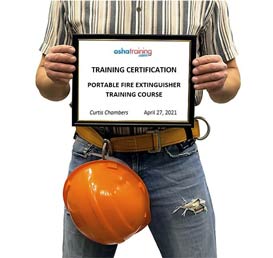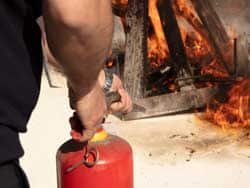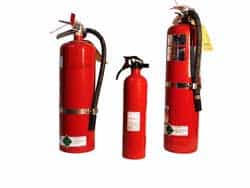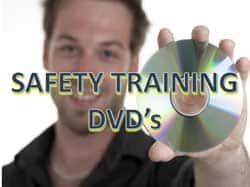Portable Fire Extinguisher Training Resources
Home Online OSHA Training Courses Portable Fire Extinguisher Training Resources
Online Portable Fire Extinguisher / Fire Prevention Training Courses
OSHA requires employers who provide fire extinguishers in the workplace that are available for employee use to also provide an “educational program” for affected workers that covers the principles of fire extinguisher use as well as the hazards of incipient-stage (early stage) fire-fighting. This educational program must be provided as part of new employee orientations, and the employer must also provide an annual refresher training on this topic.
In addition, the employer must provide all fire brigade members, as well as fire watches and any other worker who has been assigned any job that requires the use of a portable fire extinguisher, with hands-on training on the equipment they will be required to use.
We offer inexpensive OSHA-compliant interactive online courses on fire extinguisher use and fire prevention measures below that incorporates a quiz and presents the user with a personalized training certification. Online courses are designed to be taken by one student. Companies and organizations wishing to have multiple people take an online course may click the button below to purchase multiple (2+) courses, where they will be directed to a page where they can register as a Learner Manager, purchase multiple courses, and assign them to their group of students (group discount rates are automatically applied if you purchase five + courses).
Trainees will be able to begin training after they are registered for their online fire extinguisher training courses. Or, they can log in later (the log in link appears on their confirmation email sent to them when their course is assigned by their Learner Manager). One of the major benefits of taking our online portable fire extinguisher training courses is the trainee may log out of their course at any time, and can log back in later to resume training, even from a different computer or tablet. Students are allotted up to six months to complete their course, but they can certainly complete it much quicker (even in a single sitting) since their course is available for them to log in 24/7/365.
Last but not least, we also provide DVD training kit, complete with handouts, that employers can use for in-house fire extinguisher training programs. Our safety training Videos/DVD’s are available in both English and in Spanish.


Online Fire Extinguisher / Fire Prevention Training Course
Starts at just $9.99

Online Fire Extinguisher Annual Refresher Training Course
Starts at just $5.99
Frequently Asked Questions about Portable Fire Extinguisher Training
Get answers to common questions about portable fire extinguisher training requirements from an OSHA Expert with extensive experience, training, and education in OSHA compliance matters. The information provided in this section about the OSHA fire extinguisher training requirements is for GENERAL INFORMATIONAL purposes only, and is NOT TO BE CONSIDERED LEGAL ADVICE. Employers and others reading this information are advised to contact a qualified safety professional, if needed, to get further guidance about the FAQ’s below.
The Federal Occupational Safety and Health Administration, or OSHA, regulates portable fire extinguishers in the workplace. While portable fire extinguishers are addressed in many different sections of the OSHA regulations, the primary OSHA standards regarding fire extinguishers for construction sites are found in 29 CFR 1926.150. And the primary standards for general industry workplaces are found in 29 CFR 1910.157.
Those two OSHA standards both require that when portable fire extinguishers are provided for employee use in the workplace, employers must also provide to their employees an “educational program” covering the principles of portable fire extinguisher use. In addition, employees must also be provided with information about the hazards associated with incipient, or early-stage, fire-fighting.
Actual hands-on practice and training in the use of fire extinguishers is required for employees (if any) who have been specifically designated to use an extinguisher as part of their job function, such as fire brigade members and persons serving as a fire watch on a hot work crew.
For all other employees who are not assigned specific fire-fighting duties, but who work in areas where portable fire extinguishers are available for use, the employer must provide them with an “educational program” covering the principles of portable fire extinguisher use, as well as with information about the hazards associated with incipient, or early-stage, fire-fighting.
OSHA standards require the informational program be provided as soon as an employee is assigned to a job where portable fire extinguishers are present and available for use. And hands-on training is required for any worker when they are appointed to a task or position that specifically requires them to use a portable fire extinguisher as part of their job. In addition to this initial fire extinguisher training and information, OSHA standards require all workers to be provided with an annual refresher on portable fire extinguisher use.
As stated earlier, portable fire extinguishers are only intended for use on what are known as incipient stage fires, which is defined as a fire that is in it’s initial, or beginning stage, can be handled safely with a portable extinguisher, and does not require the use of special Personal Protective Equipment, such as bunker gear or a respirator. Portable fire extinguishers are NOT intended to be used for fighting large fires!
No. There are many different types of portable fire extinguishers, and using the wrong kind on a fire means you may not be able to extinguish it safely and effectively. For example, most everyone knows that water and oil don’t mix. And that is the reason you would not use an extinguisher that sprays water on burning liquids; That can actually make the flames spread.
Some fire extinguishers are intended for use on a single type, or class, of fire material, while others are designed for use on a combination of two or more classes of fire material. Always check the label on your extinguishers to understand which type, or types, of fire they are intended to extinguish.
There are several types of fire extinguishers designed for use on different types of fire material. They are:
Class A rated fire extinguishers are suitable for use on ordinary combustible materials such as Wood, paper or cardboard, dry vegetation, and some plastics. Basically, most anything that leaves an ash after it burns is a class A fire material. Class A fire extinguishers often contain water that is sprayed on the fire; So, do NOT ever use water to extinguish a flammable liquid fire. Nor would you want to use a water extinguisher on an electrical fire, for obvious reasons.
Class B rated fire extinguishers ARE suitable for use on fires involving flammable liquids, such as gasoline and diesel, solvents, and oil or grease. These extinguishers often contain gaseous carbon dioxide, or CO2, which displace oxygen so the fire cannot continue to burn. While they can be effective, the CO2 can displace the oxygen inside of a small enclosed space. So only use these extinguishers where there is plenty of natural ventilation. Also, the horn-shaped nozzle where the gas is discharged can become extremely cold; cold enough to cause frostbite, in fact. So, use caution when handling one of these type extinguishers.
A portable fire extinguisher with a Class C rating means the fire extinguisher can be used on a fire near, or involving, energized electrical equipment. This designation is typically seen on a combination type fire extinguisher that is designed for use on type A and type B fires too.
Class D rated fire extinguishers will be marked with symbols similar to those pictured here. These specialty fire extinguishers are intended to be used on fires involve metals that actually burn, such as Magnesium, Sodium, or Potassium. Class D extinguishers usually contain a dry powder that is sprayed onto the burning material in an attempt to smother out the fire in a manner that is similar to throwing a blanket over a fire.
Class K rated fire extinguishers, which are the newest type extinguisher on the market, are designed for use on kitchen fires, specifically those involving pans or deep fryers containing animal-based oils or fat, as well as vegetable oil.
Some fire extinguishers are rated for use on only one class of fire material, such as A, or B or D. However, many fire extinguishers are designed for use on a combination of two or more classes of fire material. For example, there are foam extinguisher rated for use on fires involving class A & B fire materials, while CO2 extinguishers are typically suitable for use on class B and C fires. But the most prevalent type extinguisher found in most work places are the Combination ABC portable fire extinguishers. These extinguishers commonly contain a powered chemical that smothers out a fire, much like you could by covering the fire with a blanket. The powdered chemical also interacts with the heat and flame to interfere with the combustion process. These type extinguishers can be used to extinguish fires involving ordinary combustible materials, flammable liquids, and electrical equipment.
Check the labels of the portable fire extinguishers in your workplace so you will know what type, or types, of fire they are rated to extinguish.
It depends on the size of the extinguisher. A relatively small portable fire extinguisher, like a dry chemical extinguisher designated as a “5” ABC, will only last about 6 to 10 seconds before it is emptied. A larger extinguisher, such as one designated as a “20”ABC, will last somewhere around 25 to 35 seconds before it is emptied. While that is certainly a longer time, most people are initially surprised at how fast even a large fire extinguisher can be depleted.
There are four basic steps to using most portable fire extinguishers. However, people sometimes panic when they see a fire, and forget how to operate the extinguisher. And skipping just one of these four steps may prevent the extinguisher from operating properly and putting out the fire as intended. So, to help you remember the four basic steps of portable fire extinguisher use, just remember P-A-S-S, or PASS.
The P stands for PULL the retainer pin that is positioned in the handle to keep the extinguisher from being accidentally discharged. Stand several feet back from the fire while holding the extinguisher in one hand, insert your finger into the round end of the retainer pin, and firmly pull. And don’t worry; the thin plastic band that holds the retainer pin in place on most portable extinguishers will break relatively easily.
The second step is to AIM the nozzle or discharge hose DOWN, towards the base of the fire. The idea is to apply the fire extinguishing media towards the material that is actually burning, and not at the flames that may be leaping up high.
Step three is to SQUEEZE the handle to discharge the fire extinguisher. If you let go of the handle, the discharge will stop, and if you can squeeze it again it will resume.
And the fourth step is to SWEEP the extinguisher from side to side as you slowly approach the fire. This allows you to cover all of the burning material, and not just that located where you initially point the fire extinguisher.
No. ALWAYS, turn in any portable fire extinguisher which has had its pin pulled out of the handle so it can be checked. Even if you did not actually squeeze the handle to discharge any of the fire extinguishing media, you may have broken the internal seal that maintains the pressure inside of the extinguisher. So, play it safe, and turn in that extinguisher to have it re-inspected.
The first thing to keep in mind is to never get yourself in a position where you could be trapped should the fire spread. Always maintain a clear path away to the nearest exit or other safe area, and immediately evacuate the area if the flames, heat, or smoke seem to be getting out of control. And once you have extinguished the fire, keep an eye out for flare-ups. Sometimes the fire continues to smolder beneath the burnt debris, so it is not uncommon for a fire to re-ignite several minutes later.
Fire extinguishing media such as water or foam that has been sprayed on a fire can collect on the floor and cause you to slip, as can ash from burnt materials, or liquids from containers that might have burst during a fire. So don’t run; just walk in a controlled manner so you don’t slip and fall. Also keep an eye out for any boxes, pallets, or other materials that are placed on shelves or stacked high near the fire area, as they could become unstable from fire damage and fall over on you.
Yes, if you use a suitable DVD training kit or online training course for portable fire extinguisher use. These two types of training resources can also be supplemented with hands-on training for those employees who are assigned to jobs requiring use of a portable fire extinguisher.
As with any training, it is a good idea to certify the fire extinguisher training and information were provided by preparing a written certification containing the student’s name(s), name(s) of the trainer(s), date of training, and which identifies as a certification of portable fire extinguisher training.
See our OSHA training resources for portable fire extinguisher use below.
Helpful Information About How Different Types of Fire Extinguishers Work
Portable fire extinguishers put out fires by removing one or more elements of the fire triangle: heat, fuel, or oxygen. Here’s how the main types work:
Water (Class A) Extinguishers
How it Works: Cools the burning material by absorbing heat and reducing the temperature below the combustion point.
Effective On: Ordinary combustibles like wood, paper, cloth (Class A fires).
Not for: Electrical or flammable liquid fires, as water conducts electricity and can spread burning fuel.
Carbon Dioxide (CO₂) Extinguishers
How it Works: Replaces oxygen around the fire with CO₂, smothering the flames. Also cools the fire due to CO₂ expanding rapidly when released.
Effective On: Flammable liquids (Class B) and electrical fires (Class C).
Not for: Ordinary combustibles (Class A), as fire can reignite once the CO₂ dissipates.
Dry Chemical Extinguishers (ABC or BC)
How it Works: Releases a fine powder (usually monoammonium phosphate or sodium bicarbonate) that coats the fuel, interrupts the chemical reaction, and smothers flames.
Types:
ABC Dry Chemical – Works on Class A, B, and C fires.
BC Dry Chemical – Works on Class B and C fires only (not effective on Class A materials).
Not for: Confined spaces, as the powder can impair breathing and visibility.
Class D (Metal Fire) Extinguishers
How it Works: Uses dry powder (like sodium chloride or graphite) that smothers the burning metal by forming a crust over it, blocking oxygen.
Effective On: Burning metals like magnesium, titanium, or sodium.
Not for: Any other fire types, as the powder is designed specifically for metals.
Wet Chemical (Class K) Extinguishers
How it Works: Releases a potassium-based solution that cools the fire and reacts with burning cooking oils or fats to create a soapy layer that smothers flames.
Effective On: Kitchen fires involving grease (Class K).
Not for: Electrical or flammable liquid fires.
Helpful Information to Help You Understand Fire Extinguisher Numbers and Ratings
Fire extinguisher size and effectiveness are identified by numbers in their designation (e.g., 5A:10B:C or 20B:C). Here’s what they mean:
1. Class A Ratings (2A, 5A, 10A, etc.)
The number represents the equivalent amount of water the extinguisher holds.
1A = Equivalent to 1.25 gallons of water.
2A = 2.5 gallons of water, 5A = 6.25 gallons, and so on.
A higher A rating means more cooling and soaking power for Class A fires.
2. Class B Ratings (10B, 20B, 40B, etc.)
The number represents the square footage of flammable liquid the extinguisher can handle.
10B = Can cover 10 square feet of flammable liquid fire.
40B = Can cover 40 square feet, and so on.
3. Class C Rating (Electrical Fires)
The C rating means the extinguisher is non-conductive and safe for use on electrical fires.
Class C does not have a numerical rating; it simply means the extinguishing agent won’t cause electrical shock.
4. Class D and K Ratings
Class D (metal fires) and Class K (kitchen fires) don’t use numbers because their effectiveness depends on the specific type of metal or cooking oil involved.
The manufacturer provides testing data for specific fire types.
Examples of Portable Extinguisher Ratings and What They Mean
5A:10B:C – Can fight Class A fires equivalent to 6.25 gallons of water, handle a 10-square-foot flammable liquid fire, and is safe for electrical fires.
10A:60B:C – More powerful, can fight Class A fires with 12.5 gallons of water equivalence, cover a 60-square-foot flammable liquid fire, and is safe for electrical use.
200B:C – Large extinguisher designed for 200 square feet of flammable liquid fire and electrical hazards.
Class K Extinguisher – No numbers, but designed specifically for kitchen grease fires.

